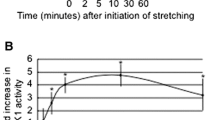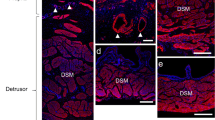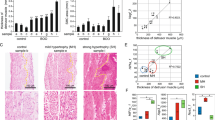Abstract
Partial obstruction of the rabbit bladder outlet induces a rapid hypertrophy characterized by increased bladder mass, increased smooth muscle content, and increased collagen deposition. In addition, partial outlet obstruction induces decreased contractile responses to both field stimulation and postsynaptic receptor stimulation. Although the morphological and contractile responses to partial outlet obstruction have been well characterized, there is little information on the cellular and molecular mechanisms of these changes. In a previous study, we demonstrated that one of the earliest genes to be expressed following partial outlet obstruction in rabbits was the gene expressing stress protein-70 (HSP-70). In order to further define the genetic and molecular basis of these responses, the expression of stress gene products HSP-70 and HSP-90 in rabbit urinary bladder subjected to partial outlet obstruction has been quantitatively evaluated by Western blot coupled with laser densitometry using anti-HSP-70 and-90 monoclonal antibodies. The data show that stress gene products HSP-70 and HSP-90 are constitutively expressed in control rabbit bladder tissue and transiently increased following partial outlet obstruction. Increased content of HSP-70 was detected at 6 hr after obstruction and reached a maximum (2.7-fold over the control level) at 24 hr. Increased HSP-90 was also detected at 6 hr but reached a maximum (4.5-fold over the control level) at 12 hr. By 7 day post-obstruction, the content of these two proteins returned to the control levels. This study suggests that alterations of stress gene expression resulting in increased HSP-70 and 90 may play an important role in the response of the bladder to partial outlet obstruction.
Similar content being viewed by others
References
Walsh PC: Benign Prostatic Hyperplasia. Drach GW: Urinary Lithiasis. Droller MJ: Transitional Cell Cancer: Upper Tract and Bladder. In: Walsh PC, Gittes RF, Perlmutter AD, Stamey TA (eds) Campbell's Urology, 5th edition. W.B. Saunders Company, Philadelphia, 1986, pp 1248–1261, 1094–1172, 1343–1408
Levin RM, Longhurst PS, Monson FC, Kato K, Wein AJ: Effect of bladder outlet obstruction on the morphology, physiology and pharmacology of the bladder. Prostate (Suppl) 3: 9–26, 1990
Kato K, Monson FC, Longhurst PA, Wein AJ, Haugaard N, Levin RM: The functional effects of long-term outlet obstruction on the rabbit urinary bladder. J Urol 143: 600–606, 1990
Malkowicz SB, Wein AJ, Elbadawi A, Van Arsdalen K, Ruggieri MR, Levin RM: Acute biochemical and functional alterations in the partially obstructed rabbit urinary bladder. J Urol 136: 1324–1329, 1986
Kim Y, Samuel M, Levin RM, Chacko S: Characteristics of contractile and cytoskeletal proteins in the hypertrophic urinary bladder smooth muscle. J Urol 143: 345A, 1990
Samuel M, Kim Y, Horiuchi KY, Levin RM, Chacko S: Smooth muscle myosin isoform distribution and myosin ATPase in hypertrophied urinary bladder. Biochem Internat 26: 645–652, 1992
Sterling AM, Ritter FC, Zinner NR: The physical basis of obstructive uropathy. In: Hinman Jr F (ed) Benign Prostatic Hypertrophy. Springer-Verlag, New York, 1983, pp 433–442
Burdon RH: Heat shock and the heat shock proteins. Biochem J 240: 313–324, 1986
Lindquist S: The heat-shock response. Annu Rev Biochem 55: 1151–1191, 1986
Ashburner M: The effect of heat shock and other stress on gene activity. In: Schlesinger MJ, Ashburner M, Tissieres A (eds) Heat shock: From bacteria to man. Cold Spring Harbor Laboratory Press, Cold Spring Harbor, NY, 1982, pp 1–9
Nover L, Scharf KD: Heat Shock Protein. In: Novel L (ed) Heat shock response. CRC Press Inc, Boca Raton, Florida, 1991, pp 42–102
Schlesinger MJ: Heat shock proteins: the search for functions. J Cell Biology 103: 321–325, 1986
Pelham HR: Speculations on the functions of the major heat shock and glucose-regulated proteins. Cell 46: 959–961, 1986
Welch WJ: The mammalian stress response: Cell physiology and biochemistry of stress proteins. In: Morimoto RI, Tissieres A, Georgopoulos C (eds) Stress Proteins in Biology and Medicine. Cold Spring Harbor Laboratory Press, Cold Spring Harbor, NY 1990, pp 223–278
Welch WJ: The mammalian heat shock (or stress) response: A cellular defense mechanism. Adv Exp Med Biol 225: 287–304, 1987
Buttyan R, Jacobs BZ, Blaivas JG, Levin RM: Early molecular response to rabbit bladder outlet obstruction. Neurourol Urodyn 11: 225–238, 1992
Laemmli UK: Cleavage of structural proteins during the assembly of the head of bacteriophage T4. Nature 227: 680–685, 1970
Burnette WN: ‘Western Blotting’: Electrophoretic transfer of proteins from sodium dodecyl sulfate-polyacrylamide gels to unmodified nitrocellulose and radiographic detection with antibody and radioidinated protein. Anal Biochem 112: 195–203, 1981
Zhao Y, Levin RM, Monson FC, Chacko S: Expression of constitutive heat shock protein-70 in normal (non-stressed) rabbit urinary bladder tissue. Mol Cell Biochem 121: 12–19, 1993
Monson FC, McKenna BA, Wein AJ, Levin RM: Effect of outlet obstruction on3H-thymidine uptake: A biochemical and radioautographic study. J Urol 148: 158–162, 1992
Ritossa F: A new puffing pattern induced by heat shock and DNP in Drosophila. Experientia 18: 571–573, 1962
Caltabiano MM, Koestler TP, Poste G, Greig RG: Induction of 32–34 kDa stress proteins by sodium arsenite, heavy metals and thiol-reactive agents. J Biol Chem 261: 13381–13386, 1986
Hamet P, Malo D, Hashimoto T, Tremblay J: Heat stress genes in hypertension. J Hypertension 8 (suppl 7): S47-S52, 1990
Mizzen LA, Welch MJ: Characterization of the thermotolerant cell: I. Effects on protein synthesis activity and the regulation of heat-shock protein 70 expression. J Cell Biol 106: 1105–1116, 1980
Subjeck IR, Sciandra J, Johnson RJ: Heat shock proteins and thermotolerance: Comparison of induction kinetics. Br J Radiol 55: 579–584, 1982
Riabowol KT, Mizzen LA, Welch WJ: Heat shock is lethal to fibroblasts microinjected with antibodies against HSP-70. Science 242: 433–436, 1988
Gething MJ, Sambrook J: Protein folding in the cell. Nature 355: 33–45, 1992
Lewis MJ, Pelham HR: Involvement of ATP in the nuclear and nucleolar functions of the 70 kd heat shock protein. EMBO J 4: 3137–3143, 1985
Hartkm FU, Pfanner M, Neupert W: Role of heat shock proteins in protein translocation across mitochondrial membranes. FASEB J 4: 3137–3143, 1992
Neupert W, Hartl FU, Craig EA, Pfanner N: How do polypeptides cross the mitochondrial membrane. Cell 63: 447–450, 1990
Kingston RE, Baldwin AS Jr, Sharp PA: Regulation of heat shock protein 70 gene expression by c-myc. Nature 312: 280–282, 1984
Wu BJ, Hurst HC, Jones NC, Morimoto RI: The E1A 13S product of adenovirus 5 activates transcription of the cellular human HSP-70 gene. Mol Cell Biol 6: 2994–2999, 1986
Santoro MG, Garaci F, Amici C: Prostaglandins with antiproliferative activity induce the synthesis of a heat shock protein in human cells. Proc Natl Acad Sci 86: 8407–8411, 1989
Catelli MG, Binart N, Jung-Testas I, Renoir JM, Baulieu EE, Feramisco JR, Welch WJ: The common 90 KD protein component of non-transformed ‘8S’ steroid receptors is a heat shock protein. EMBO J 4: 3131–3137, 1985
Wilhelmsson A, Cuthill S, Denis M, Wikstrom AC, Gustafsson JA, Poellinger L: The specific DNA binding activity of the dioxin receptor is modulated by the 90 kDa heat shock protein. EMBO J 9: 69–76, 1990
Author information
Authors and Affiliations
Rights and permissions
About this article
Cite this article
Zhao, Y., Chacko, S. & Levin, R.M. Expression of stress proteins (HSP-70 and HSP-90) in the rabbit urinary bladder subjected to partial outlet obstruction. Mol Cell Biochem 130, 49–55 (1994). https://doi.org/10.1007/BF01084267
Received:
Accepted:
Issue Date:
DOI: https://doi.org/10.1007/BF01084267




